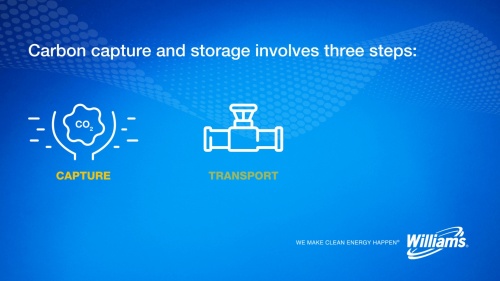One of the tools to help Williams achieve net zero emissions is Carbon Capture and Storage (CCS.)
CCS is a term that refers to technologies that capture carbon dioxide (CO2) and store it safely underground.
Williams already captures CO2 at some of our gas processing and treatment plants, including our Dilley treatment facility in Texas and Parachute Creek gas processing plant in Colorado. Participating in the CCS value chain can reduce our operational emissions and support our customers’ emissions reduction ambitions.
To participate more fully in the low-carbon economy, Williams is exploring opportunities to capture CO2 at our gathering and processing assets, compressor stations, and at customer facilities.

Our Louisiana Energy Gateway project, expected to go into service in late 2024, is expected to incorporate carbon capture and storage, further decarbonizing natural gas production in the rapidly growing Haynesville basin.
Additionally, Williams joined the Global Carbon Capture and Storage Institute, an international think tank whose mission is to accelerate the deployment of carbon capture and storage globally. As members of the Institute, we collaborate with the broad membership base and garner the expertise of the Global CCS Institute to develop innovative projects and shape policies that prioritize CCS efforts for a lower-carbon future.
According to the Global CCS Institute, carbon capture and storage involves three steps – capture, transport and storage.
Capture
During capture, CO2 is separated from other gases produced at large industrial facilities, such as steel mills, cement plants, petrochemical facilities, coal, and gas power plants, or from the atmosphere. There are several capture methods in use – all are proven and effective, with different methods applied based on the emissions source.
Transport
Once separated, the CO2 is compressed for transportation. This means increasing pressure so that the CO2 becomes a liquid. The compressed CO2 is then dehydrated before being sent to the transport system. Pipelines are the most common mode of transport for large quantities of CO2.
Storage
Following transport, the CO2 is injected into deep underground rock formations, where it is safely and permanently stored. These rock formations are similar to what has held oil and gas underground for millions of years.
To read more about Williams and carbon capture and storage, see our latest Sustainability Report.
